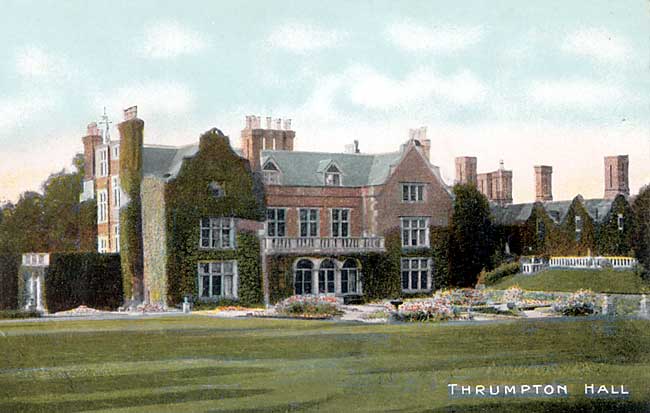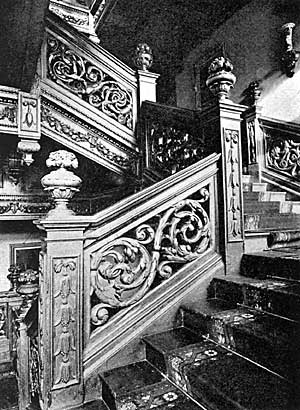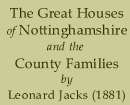< Thoresby | Contents | Thurgarton >
Thrumpton

The south front of Thrumpton Hall, c.1910.
THRUMPTON Hall was built two hundred and fifty years ago by the Pigots who were then among the county magnates. Old country houses, whether of brick or of stone, are always interesting ; it is only to be regretted that there are so few of them hereabouts. If of brick, they acquire a soft, quiet tint in old age, which does not in any way owe its existence to the prevalence of smoke, but which comes of long exposure to the sun, and to the fresh, sweet air. Thrumpton Hall is a brick building, and its outer walls have got this beautiful colour of which I speak. When the trees are in full leaf the house is by no means a conspicuous object from any point of view, and it is, perhaps, one of the few great houses near at hand, with whose proportions large numbers of people living in the county town are not familiar. Those who have only seen the house from the river, whose swift current flows a few hundred yards in front of it, or from the towing path, can form no adequate idea of its dimensions, or of its architectural character. It does not show its best side to the gaze of those who happen to be walking along the river side, or to the fishermen who try their luck in the Thrumpton waters. To get a really good view of the house you must go into the grounds, which, by the way, are not show grounds, but strictly private gardens, and there you may see the gabled front with its peculiar stone mouldings, and the square, heavy framed windows, which are a distinguishing mark of the architecture of James the First’s reign. The house is undoubtedly one of very handsome proportions, and when the sun is out, you appreciate all the more those rich brick-tints of which I have spoken. While in the grounds one is bound to take some notice of the trees, which are very fine. There are two magnificent specimens of the larch, tall, wide-spreading, and elegant. In winter, the ground beneath them is completely covered with the small needle-shaped foliage, which is pleasant to walk upon. These trees were planted upwards of a century ago, and they are said to be the finest of the kind in the county. Then there is a great cedar, which was planted in commemoration of some event when George the Third was king, and a set of glorious elms, which flourished as saplings three hundred years ago. So that there is some interesting timber within the Thrumpton domain, for several of these venerable trees have a history of their own. Near the house, and in front of the terrace, is a backwater, made from the overflow of the adjacent river, and to this retreat wild fowl come and establish a right of residence, living on good terms with their more domesticated kindred. Beyond is the river, which in flood-times becomes a nuisance to the village, though the inhabitants do not, suffer so much personal inconvenience as those of other river side parts of the county.
The mansion is on the site of an older house, which was occupied by the Putrels, and it was built, as I have said, by the Pigot family, who lived in it for several generations, and were at one time, people of considerable distinction. In 1669, in the reign of Charles the Second, Mr. Gervase Pigot, of Thrumpton, was High Sheriff of the County, and he is said by Thoroton to have been a person of great parts, both natural and acquired, and the historian adds, "for sobriety, ingenuity, generosity, piety, and other virtues, few of his rank will ever exceed, if any equal him." It would perhaps be appropriate to mention here a fact that was told to me the other day. It was at Thrumpton Hall that Thoroton made up his mind to write that very interesting and very valuable history of Nottinghamshire which is known so well. Dugdale, the Warwickshire historian, and Thoroton were guests in the house at the same time, and the former suggested to the latter that he should write a history of this county. The suggestion was, in all probability, encouraged by Mr. Pigot, who was a man of considerable attainments, and who would, no doubt, urge Thoroton to the task, a similar one to which had been so successfully undertaken by his other guest, for another midland county. Whilst Mr. Pigot was High Sheriff of this county in 1638, the wife of Sir Francis Burdett’s eldest son died, and the Sheriff adopted black liveries and silver trimmings for his javelin men. Shortly after the Assizes he died, and the men who attended him when he received the judge, carried him to the grave in those same liveries which they had worn on a melancholy occasion a few days previously. Mr. Pigot’s executors in the year above mentioned sold the manor to Mr. John Emmerton, of the Middle Temple, who bequeathed them to John Emmerton Wescomb Emmerton, the eldest son of a nephew. The estate is now in the hands of Lady Byron, a daughter of Rev. William Wescomb, an Essex clergyman, who married firstly the Hon. Captain Byron, afterwards eighth Lord Byron ; and recently Rev. Philip Douglas, rector of Thrumpton, who now resides at the hall. Her ladyship has been a true friend to Thrumpton. Some years ago she restored the church at a cost of several thousand pounds. She has also caused to be erected an excellent set of schools, and has built two additional farm houses on the estate.

The 17th century staircase at Thrumpton Hall in the 1920s.
The most conspicuous feature in the interior of Thrumpton Hall is a superb staircase. It is of wood, massive, and elaborately carved, leading from the basement storey to a suite of upper rooms. It was placed in the house sometime about 1660 by the Pigots, whose coat of arms it bears. Upon the original bearings of that family three pickaxes appeared, these devices having probably been suggested by the surname of the lord of the manor, though the connection is somewhat vague. It was afterwards discovered that the family was entitled to another coat of arms, so that two shields are part of the carving on the staircase, the second displaying a greyhound in a couchant position with a collar about his neck. The staircase is unique of its class, and is perhaps the finest example of this kind of decoration in the county. Its effect is, however, somewhat lost on account of the position in which it is placed. It does not rise immediately from the hall, as some grand staircases do it is, in fact, hidden from the view of the casual visitor, who, if he were only admitted to the principal rooms of the house, would not know that such a rare and useful piece of ornamentation existed. A large room in the upper part of the house was formerly used for reception purposes, and probably the staircase may have been devised as a means of communication with that apartment. The house is full of woodwork. The walls of most of the principal rooms are protected by it, and its colour and condition have been preserved through time, for it is fair to presume that the woodwork in the rooms is as old as that of the staircase.
Knowing that the late Lord Byron, who made this fine old house his residence for a time, was a lineal descendant of the illustrious author of "Childe Harold," I asked if the hall contained anything which would remind one of the poet. I was informed that it did not ; that such of the Byron relics as are not at Newstead were in the possession of the present peer. There are, however, some very interesting things in the house. Among the pictures I noticed several good portraits on the walls of the dining room, among them one of that distinguished naval officer, General Monk, afterwards Duke of Albemarle, who, sooner than allow any foreign fleet to dispute the British sovereignty of the seas, would have fired his pistol into the powder magazine and blown the British navy into smithereens. His presence on these walls is accounted for by the fact that he and Sir William Marshall were great friends ; and Sir William, whose portrait hangs on the same walls, was connected with Lady Byron’s family by ties of relationship. In this distinguished company, which includes Sir William Marshall’s two wives, is a Miss Appleton, one of the ladies-in-waiting to Queen Anne, who presented her with a set of gold plate, which is still in the possession of Lady Byron. There are several portraits on the staircase; one of them a stern-visaged warrior of solid proportions, very likely the sturdy Protector, who, it is known, issued a writ requiring the attendance of Gervase Pigot, of Thrumpton, at Westminster, on the 4th of July, 1653, as Member for the county of Nottingham.
The Library contains a rare collection of books, some of which are very valuable. The shelves are rich in county histories, a kind of literature which is much in demand just now, amongst them "Bloomfield’s Norfolk," "Omerod’s Cheshire," and "Nicholls’ Leicestershire." There are splendid editions of the works of the great French and German writers, and complete sets of the classics, all these being arranged in perfect order. Whilst here I had an opportunity of glancing through a small, thin volume in old fashioned print, which has a local bearing. It was written a long while ago by Sir Thomas Parkyns, of Bunny Park, in this county. It is entitled "The In play, or Cornish-Hug Wrestler," and it claims to be a digest of the method which teaches how to throw an opponent on the most approved principles. "It is easy to be understood," the title page announces, "by all gentlemen and by all tradesmen," presuming they have some previous knowledge of the rudiments of the art which its mission is to teach. The book, if I remember rightly, is dedicated to his Majesty George II., and on the frontispiece there is a rude engraving of the titled author in a wrestling attitude, after the fashion of the well known monument in Bunny Church. In a small recess above the mantelpiece there is a queer figure of the statuette order—a piece of antique sculpture representing an inebriated Bacchus, which was brought by the late Mr. Wescomb from Italy, and is said to be very valuable. In the small, bright drawing room, there is a cabinet containing a choice collection of china, in which I noticed some rare pieces of Sevres, Dresden, and Lowestoft, and a number of other interesting objects which one has not time to linger over. Not long ago a curiosity was unearthed by some member of the household, in the shape of a richly brocaded dress, which was discovered in an old trunk, along with a Nottingham newspaper, published sometime in 1749.
< Thoresby | Contents | Thurgarton >
